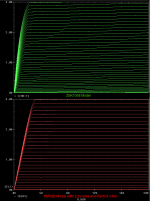Yes, but you could load the FE with an inductor instead of a resistor and remove both thermal compensation section and source degeneration resistor. Off course you can also do this with vertical MOSFET, but constrained only to low 12-16V supply voltage.But their low transconductance will do.
Member
Joined 2009
Paid Member
If you degenerate the source of a vertical so that it's transconductance is similar to a lateral, does the vertical not then have similar linearity ?
I think the answer to this question is fairly clear. See attached simulation sweep comparisons of a 2SK1058 model and an IRF630 model. A series 2.2VDC source was added to the IRF630 to lower its threshold voltage, and a 0.6 Ohm source resistor to lower its gm in order to closely match the 2SK1058.If you degenerate the source of a vertical so that it's transconductance is similar to a lateral, does the vertical not then have similar linearity ?
Attachments
Depends on what you mean by similar. The degenerated IRF part clearly
has a higher Drain impedance.
😎
has a higher Drain impedance.
😎
Indeed.
My calculations of Ro while zoomed in and using built-in cursors are as follows:
2SK1058 = 200 Ohms
IRF630 = -20k Ohms (yep, slightly negative slope!)
My calculations of Ro while zoomed in and using built-in cursors are as follows:
2SK1058 = 200 Ohms
IRF630 = -20k Ohms (yep, slightly negative slope!)
BUZ901P - SEMELAB BUZ901P - N CHANNEL MOSFET, 200V, 8A, TO-247 | Newark element14 US
Newark has semelab buz90x
Newark has semelab buz90x
BUZ901P - SEMELAB BUZ901P - N CHANNEL MOSFET, 200V, 8A, TO-247 | Newark element14 US
Newark has semelab buz90x
Are those lateral ?
Meaning for a certain Vgs, Id will be slightly lower for higher Vds? Isn't this contrary to actual device behaviour?. . . IRF630 = -20k Ohms (yep, slightly negative slope!)
I would say contrary, yes. Apparently this sim model requires some minor tweaking, even though it is directly from IRF.
I have run the same simulation again, this time with a more complex subcircuit model of the IRF630. The plateaus are now ruler flat (up to 20V anyway), indicating an Ro=infinity. In reality, there probably is a slight positive slope to all pentode-type output curves.
With a given load line, the lateral has slightly more lower-excursion output swing than the vertical.
But how does the large difference in Ro translate to how the devices will sound in a class A or AB application?
I have run the same simulation again, this time with a more complex subcircuit model of the IRF630. The plateaus are now ruler flat (up to 20V anyway), indicating an Ro=infinity. In reality, there probably is a slight positive slope to all pentode-type output curves.
With a given load line, the lateral has slightly more lower-excursion output swing than the vertical.
But how does the large difference in Ro translate to how the devices will sound in a class A or AB application?
Attachments
Last edited:
But how does the large difference in Ro translate to how the devices will sound in a class A or AB application?
It is only one of a list of factors, among them (to use tubes as an example):
Triode / Pentode
Bias
Load Line
Common Plate / Common Cathode,
Single-Ended / Push-pull
Single Stage / Multi-Stage
Loop Feedback - type and amount
Degeneration
Cancellation
Cascoding
😎
Agreed, but say we take a class A amp designed around the 2SK1058. Then we make a few minor mods (higher bias voltage and added source resistor) and replace it with an IRF630.
Now essentially the only difference is the Ro of the amp (see above output curves).
Assuming we don't push into clipping, how will they sound different?
Now essentially the only difference is the Ro of the amp (see above output curves).
Assuming we don't push into clipping, how will they sound different?
Last edited:
Member
Joined 2009
Paid Member
The decline in popularity and availability of LatFETs has a reason - they don't offer enough of an advantage over alternatives. Tubes and vertical FETs are both still in production and easily available so price (Tubes cost more than LatFETs) is not the main issue.
Agreed.The decline in popularity and availability of LatFETs has a reason - they don't offer enough of an advantage over alternatives. Tubes and vertical FETs are both still in production and easily available so price (Tubes cost more than LatFETs) is not the main issue.
Lateral fets, ~$22, whereas VFETs are about $4.
Also, in my opinion there is little if any advantage to SITs over VFETs (they can be configured to operate similar to SITs).
Last edited:
- Status
- Not open for further replies.
- Home
- Amplifiers
- Pass Labs
- why papa doesnt choose Lateral Mosfets?


